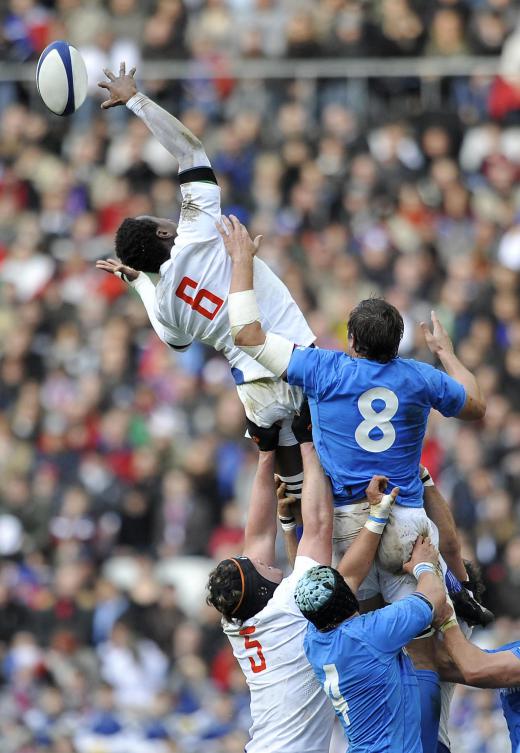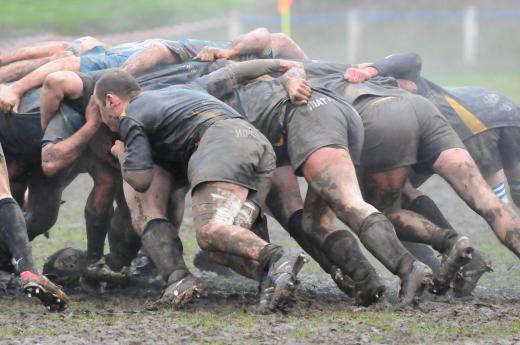At Sports&Hobbies, we're committed to delivering accurate, trustworthy information. Our expert-authored content is rigorously fact-checked and sourced from credible authorities. Discover how we uphold the highest standards in providing you with reliable knowledge.
What is Rugby?
Rugby is a sport played between two teams that try to score points by advancing a ball past the opposing team's goal line or by kicking the ball through a pair of uprights on the opponent's goal line. Players can run with the ball, kick it or pass it backward or sideways to a teammate. Opposing players try to tackle the player who has the ball or gain possession of the ball. There are two main versions: rugby union, which uses 15 players at a time for each team, and rugby league, which uses 13. Another version, rugby sevens, follows union rules but uses only seven players at a time for each team.
Field

This sport is played on a grass field marked by white lines that are painted to signify certain parts of the field. The field is measured in metric units and is 328.1 feet (100 m) from one goal line, or try-line, to the other. Past each try-line is an in-goal area of varying depth — no more than 72.2 feet (22 m) for rugby union and 19.7 to 36.1 feet (6 to 11 m) for rugby league. A rugby union field is 229.7 feet (70 m) wide, and a rugby league field is 223.1 feet (68 m) wide. At both goal lines are H-shaped goal posts that are 18.4 feet (5.6 m) wide, with the crossbar 9.8 feet (3 m) off the ground.
Ball

Rugby is played with an inflated, oval-shaped ball that was once made of leather but is now made of synthetic material. A rugby union ball is 11.0 to 11.8 inches (28 to 30 cm) long, is 22.8 to 24.4 inches (58 to 62 cm) around at its widest part and weighs 14.5 to 16.2 ounces (410 to 460 g). In rugby league, the ball is about 10.6 inches (27 cm) long, is about 23.6 inches (60 cm) around at its widest and weighs roughly 14.1 ounces (400 g). Smaller balls might be used in games played by youths.
Players

In both rugby union and rugby league, the players typically wear a shirt number based on their position. Each position has a specific role and name, such as fullback, scrum-half, center, wing and hooker. Players who have certain skills or physical traits usually are better at some positions than others. They wear shorts, shirts, long socks and no padding on their bodies. They typically wear no padding, although some wear headbands or thin padded helmets, called scrum caps, to protect their ears or to help prevent concussions.
Scoring

There are four types of scoring plays: a try, a conversion, a drop goal and a penalty kick. A try is scored when a player touches the ball to the ground inside the opposing team's in-goal area. After a try, the team that scored can attempt a conversion to score more points by kicking the ball over the crossbar and through the uprights. A drop goal is scored when a player bounces the ball on the ground, then kicks it over the crossbar and through the uprights. After certain types of penalties, a team might be awarded a penalty kick, which also is scored by kicking the ball over the crossbar and through the uprights.
The number of points that are awarded for these four types of plays depend on the type of rugby that is being played. In rugby union, a try is worth five points, a conversion is worth two points, a drop goal is worth three points, and a penalty kick is worth three points. The points in rugby league are four for a try, two for a conversion, one for a drop goal and two for a penalty kick.
Game Action
Rugby union and rugby league games consist of two 40-minute halves. Rugby sevens games consist of two seven-minute or 10-minutes halves, and games for youths also might be less than 40 minutes per half. During games, players try to advance the ball to the opposing team's in-goal area without being tackled or otherwise stopped by the opponents. Depending on the rules being used, one of four types of plays might occur when advancement is stopped, possession of the ball is lost or it goes out of bounds. These are called a scrum, a ruck, a maul and a lineout.
A scrum is when a certain number of players from each team essentially lock arms-to-shoulders, or "bind" together, then push against the opposing players in the scrum or push their own teammates from behind. The ball is then rolled into the area between the two front rows of players in the scrum, and they try to gain possession of the ball for their team by kicking it backward to a teammate. The number of players involved in a scrum depends on the version of rugby being played. There are eight from each team in rugby union, six in rugby league and three in rugby sevens.
A ruck is when the ball is on the ground and at least one player from each team is trying to gain possession of the ball with their feet. A maul occurs when the player who has the ball is being held by at least one opposing player, and at least one of the ballcarrier's teammates binds onto the ballcarrier, then all of the players try to push the ruck toward the opponent's try-line. A line-out is used in rugby union after the ball has gone out of bounds, and it involves players being lifted into the air by their teammates to try to catch the ball as it is thrown back into play.
History and Popularity
Rugby is derived from a type of football that was played during the 1800s at Rugby School in England. The sport is popular in many countries, particularly those in Europe and the South Pacific. The most famous rugby union team is national men's team of New Zealand, which is nicknamed the All Blacks. In North America, the sport is played mostly by college club teams and local amateur teams.
AS FEATURED ON:
AS FEATURED ON:














Discussion Comments
That's in interesting point about the word 'try'. I didn't know that either. --Mike
What is the aim of rugby?
I realize that you're talking to people who have no knowledge of rugby whatsoever, and so are likely to miss out a few fine details, but I'd like to clarify that a rugby union played with 13 players does not exist, and rugby sevens games do not last for 80 minutes.
I know I'm being pretty anal here but I just wanted to point that out.
@CoveredInIt - I think a drop goal is only worth 1 point in Rugby League and 3 in Rugby Union. That's interesting about the word "try" though, I didn't know that.
I'd like to clarify a little something about how points are scored in rugby.
In Rugby Union or League the act of grounding the ball in the 'end-zone" is called a "try". This is worth 5 points in Union and 4 in League. The ball must be grounded with downward pressure and the ball must not leave the hands of the scorer until the act of grounding is complete. If a player runs into the try-area and drops the ball, no try is awarded and the scoring team must go back 5 yards to the last passage of play.
The kick at goal that follows is called a "conversion" whereby the scoring team's kicker is allowed a chance to "convert" the 5 or 4 points into 7 or 6 points. The kick is taken in line with where the try was scored, typically most teams encourage players to score under the posts for ease of conversions.
Historically the reason this act is called a "try" is because it had no value in itself and was just an opportunity for the attacking team to "try" for goal.
One other method of scoring is the drop-goal. A player must bounce the ball on the floor in open play and then kick it through the posts in one continuous movement, this is worth 3 points and is often the decider in tight matches between equally-matched sides.
Post your comments